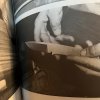- Joined
- Jun 3, 2019
- Messages
- 2,714
I am still looking at emulating the guard construction technique demonstrated in the Loveless video - and I am still pondering something: Loveless makes no point at all about having a sharp inside corner in the notch he grinds out for his bolster/guard - he just profiles it and sends it out for heat treating. *Yet* - there is this pervasive statement on this forum that one should NOT have a sharp inside corner, because this acts as a stress riser - and can/will lead to fracture at that point during HT.
Question: has anyone actually experienced a crack/failure of a blade, especially during HT, that started at a sharp inside corner?
Question: has anyone actually experienced a crack/failure of a blade, especially during HT, that started at a sharp inside corner?

